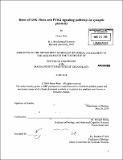| dc.contributor.advisor | Morgan Sheng. | en_US |
| dc.contributor.author | Hsin, Honor | en_US |
| dc.contributor.other | Massachusetts Institute of Technology. Dept. of Biology. | en_US |
| dc.date.accessioned | 2010-08-31T14:47:56Z | |
| dc.date.available | 2010-08-31T14:47:56Z | |
| dc.date.copyright | 2010 | en_US |
| dc.date.issued | 2010 | en_US |
| dc.identifier.uri | http://hdl.handle.net/1721.1/57798 | |
| dc.description | Thesis (Ph. D.)--Massachusetts Institute of Technology, Dept. of Biology, 2010. | en_US |
| dc.description | Cataloged from PDF version of thesis. | en_US |
| dc.description | Includes bibliographical references. | en_US |
| dc.description.abstract | Activity-dependent modification of synapses, as in long term potentiation (LTP) or long term depression (LTD), is widely believed to be a crucial mechanism for learning and memory. Molecular perturbations in these processes may underlie certain neuropsychiatric conditions. This thesis examines the role of two signaling pathways, glycogen synthase kinase 3 beta (GSK- 3beta) and proline-rich tyrosine kinase 2 (PYK2), in LTD at rat hippocampal synapses. GSK-3beta, a serine/threonine kinase implicated in the pathophysiology of schizophrenia, mood disorders, and Alzheimer's disease, is known to play a critical role in LTD. Here we report that GSK-3beta phosphorylates the postsynaptic scaffold protein PSD-95, a major determinant of synaptic strength, at the Thr- 19 residue. In hippocampal neurons, this promotes the activity-dependent dispersal of synaptic PSD-95 clusters. We found that overexpression of a phospho-null mutant (Ti 9A-PSD-95), but not a phospho-mimic mutant, blocks LTD without affecting basal synaptic function relative to wild type PSD-95 overexpression. Thus PSD-95 phosphorylation by GSK-3beta is a necessary step in LTD. [This project is a collaboration with Myung Jong Kim, and I am second author of the manuscript.] PYK2 is a calcium-dependent tyrosine kinase that is activated in cerebral ischemia and seizures. PYK2 is also known to bind PSD-95 at a region implicated in LTD signaling. Here we report a novel role for PYK2 in LTD. Chemical LTD treatment induces PYK2 phosphorylation at Tyr-402, and small hairpin RNA-mediated knockdown of PYK2 blocks LTD, but not LTP. We identify both enzymatic and non-enzymatic (scaffolding) roles for PYK2 in LTD, and find that PYK2 is required to suppress activity-dependent phosphorylation of the mitogen activated protein kinase ERK. ERK activity is believed to promote glutamate receptor insertion at synapses. Overexpression of WT-PYK2 further depresses activity-dependent ERK phosphorylation, and inhibits LTP, but not LTD. Our studies support a model whereby PYK2 antagonizes ERK signaling to promote LTD, at the expense of LTP, in hippocampal neurons. [This project is a collaboration with Myung Jong Kim and Chi-Fong Wang, and I am first author of the manuscript.] | en_US |
| dc.description.statementofresponsibility | by Honor Hsin. | en_US |
| dc.format.extent | 171 p. | en_US |
| dc.language.iso | eng | en_US |
| dc.publisher | Massachusetts Institute of Technology | en_US |
| dc.rights | M.I.T. theses are protected by
copyright. They may be viewed from this source for any purpose, but
reproduction or distribution in any format is prohibited without written
permission. See provided URL for inquiries about permission. | en_US |
| dc.rights.uri | http://dspace.mit.edu/handle/1721.1/7582 | en_US |
| dc.subject | Biology. | en_US |
| dc.title | Roles of GSK-3beta and PYK2 signaling pathways in synaptic plasticity | en_US |
| dc.type | Thesis | en_US |
| dc.description.degree | Ph.D. | en_US |
| dc.contributor.department | Massachusetts Institute of Technology. Department of Biology | |
| dc.identifier.oclc | 654124453 | en_US |
